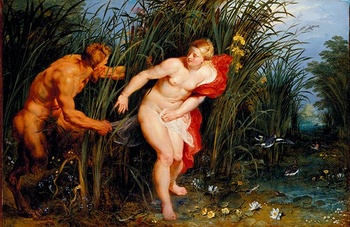Peter Paul Rubens: his master’s legacy

Peter Paul Rubens (1577–1640) had an influence throughout Europe. Not only did his diplomatic career take him to London and Madrid, but he himself ensured that his works would be reproduced in prints that circulated widely. That spread his work through geographical space; it has also remained in the public eye down the centuries: generations and generations of artists have admired, studied, and copied his works, which offered fertile ground for their own imaginations. It is this profound, sustained influence that the "Rubens and His Legacy" exhibition sets out to highlight, with “guests” as prestigious as Turner, Delacroix, Géricault, Klimt, and Picasso. Not convinced? Here are five good reasons to take a look.
1 The prince of Flemish baroque
The first and the best reason of all, of course, is Rubens himself, who is to the Spanish Low Countries what Velázquez is to Spain and Poussin to France: an absolute master of the baroque movement. Creating a revolutionary synthesis of Flemish sensibility and the spirit of the great Italian masters (Michelangelo, Raphael, Titian, and his own contemporary Caravaggio), whom he went off to study for eight years after his training in Antwerp, Rubens made a name for himself through the artistry with which he made colours come to life, modelled flesh, hair, and textiles by his skilfully orchestrated use of light, and created dynamic compositions while maintaining the balance and readability of his scenes. This exhibition brings together twenty of his paintings, as well as sketches in oils, a series of drawings, and prints. A fine ensemble.

Delacroix called Rubens “the Homer of painting”. And the standard-bearer of French Romanticism was far from being the only one to have been profoundly influenced by the great Peter Paul. Van Dyck and Jordaens both worked in his Antwerp studio; the young Rembrandt was an admirer; Antoine Wiertz saw himself as his reincarnation; Fragonard and Renoir copied him; Manet used several of his compositions as the starting points for works of his own; Cézanne studied his series devoted to Marie de Médicis... The confrontation between Rubens and some of his innumerable heirs is at the heart of this exhibition, which includes work by, among others, Jean-Baptiste Carpeaux, John Constable, Honoré Daumier, Antoine Watteau, William Turner, Théodore Géricault, and Gustav Klimt…and all the way up to Oskar Kokoschka and Pablo Picasso. Outstanding figures, all of them.
3 Flesh, the sceptre, and blood
Rubens was equally eminent as a brilliant creator of intense religious scenes in his role as an exponent of the Counter-Reformation, as a painter of virtuoso allegories drawn from mythology, and as a portrayer of the powerful. The exhibition brings Rubens face to face with those he inspired. It does so under six headings – violence, power, lust, compassion, elegance, and poetry – that together present a rich, sharply contrasting overview of the Antwerp master’s prowess. From turbulent hunting scenes and the brutality of mythical abductions to the well-endowed bodies of goddesses and nymphs and the cold flesh of Christ’s corpse, alongside the greats of this world immortalised at the height of their glory and some serene rural landscapes.

4 KMSKA, Prado, Hermitage, etc.
Antwerp’s Royal Museum of Fine Arts (KMSKA), a major conserver of works by Rubens, will remain closed for renovations until 2017, but that doesn’t prevent it from promoting its collection. In the current Brussels exhibition, for example, you can see the outstanding Venus Frigida and the triptych of Christ on the Straw. But those are just two of the many prestigious loans that have gone to make the Brussels show such an event. In terms of works by Rubens himself, one could mention the State Hermitage Museum in St Petersburg, which provided The Coronation of Marie de Médicis, the Kunsthistorisches Museum in Vienna, which has lent The Hermit and the Sleeping Angelica, the Nationalmuseum in Stockholm, source of a Bacchanalia, and the Prado in Madrid, which allowed its precious Garden of Love to travel for the occasion. In short, there have been contributions from every quarter.

5 Interdisciplinary
This prestigious event also involves other disciplines. In addition to being complemented by cinema and music events, the exhibition features a visitor’s guide that includes texts by some excellent writers in French and Dutch. David Bosc, Annemarie Estor, Lydia Flem, Peter Holvoet-Hanssen, Pjeroo Roobjee, and Jean-Philippe Toussaint have each written a text inspired by one of the great master’s works; their texts are also to be found on the videoguide. The French-German theatre director Ingrid von Wantoch Rekowski and the London-based visual artist Quayola will each present a multimedia installation based on Rubens’s work at the Bozar Night (10 November) and the Bozar Electronic Arts Festival (25 > 27 September). So Rubens continues to inspire...
(Image on the left: Honoré Daumier, Woman Pursued by Satyrs, The Montreal Museum of Fine Arts, Adaline Van Horne Bequest - Photo: The Montreal Museum of Fine Arts, Brian Merrett)
SENSATION AND SENSUALITY. RUBENS AND HIS LEGACY • 25/9 > 4/1, di/ma/Tu > zo/di/Su 10 > 17.30 (do/je/Th: 10 > 20.30), €2/6/12/14, Bozar, rue Ravensteinstraat 23, Brussel/Bruxelles, 02-507.82.00, www.bozar.be
Read more about: Expo
Fijn dat je wil reageren. Wie reageert, gaat akkoord met onze huisregels. Hoe reageren via Disqus? Een woordje uitleg.